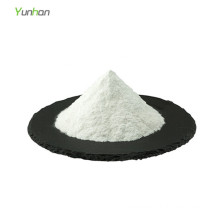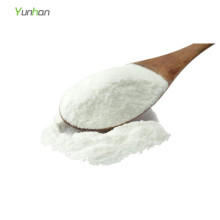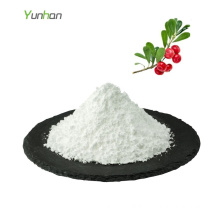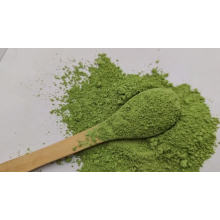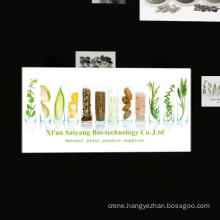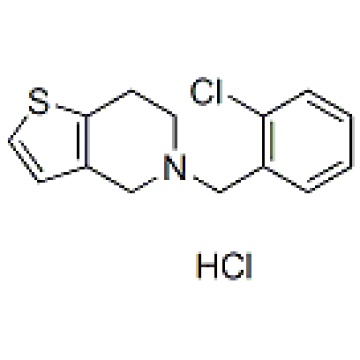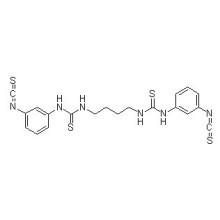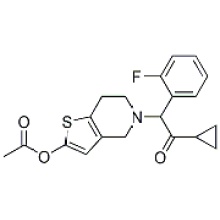Ticlopidine HCl 53885-35-1
Product Description
.cp_wz table {border-top: 1px solid #ccc;border-left:1px solid #ccc; } .cp_wz table td{border-right: 1px solid #ccc; border-bottom: 1px solid #ccc; padding: 5px 0px 0px 5px;} .cp_wz table th {border-right: 1px solid #ccc;border-bottom: 1px solid #ccc; padding: 5px 0px 0px 5px;}
Molecular Weight: 300.25 Ticlopidine HCl is an P2 Receptor Inhibitor against ADP-induced platelet aggregation with IC50 of ~2 μM.
Ticlopidine HCl is an antiplatelet drug in the thienopyridine family.
Ticlopidine HCl inhibits platelet aggregation by altering the function
of platelet membranes by blocking ADP receptors. This prevents the
conformational change of glycoprotein IIb/IIIa which allows platelet
binding to fibrinogen. Ticlopidine HCl inhibits platelet
aggregation and prostaglandin synthesis from endogenous substrate
through activating basal and PGE1-stimulated activity of the cyclase,
preventing PGE2-induced depression of the cyclase activity and thus
increasing platelet c-AMP level.
Ticlopidine HCl inhibits platelet aggregation with IC50 of ~2 μM in men. Ticlopidine HCl, when orally administered to rats, results in
activation of basal and prostaglandin E1 (PGE1)-stimulated adenylate
cylase activity through increase in affinity of the cyclase in platelet
membrane to PGE1, although it failed to affect adenosine- or sodium
fluoride-stimulated activity of the enzyme.
Protocol(Only for Reference)Conversion of different model animals based on BSA (Value based on data from FDA Draft Guidelines)
For example, to modify the dose of resveratrol used for a mouse (22.4 mg/kg) to a dose based on the BSA for a rat, multiply 22.4 mg/kg by the Km factor for a mouse and then divide by the Km factor for a rat. This calculation results in a rat equivalent dose for resveratrol of 11.2 mg/kg.
Chemical Information
Contact us if you need more details on 53885-35-1 Ticlopidine HCl. We are ready to answer your questions on packaging, logistics, certification or any other aspects about 53885-35-1、Ticlopidine HCl 53885-35-1. If these products fail to match your need, please contact us and we would like to provide relevant information.
Molecular Weight: 300.25 Ticlopidine HCl is an P2 Receptor Inhibitor against ADP-induced platelet aggregation with IC50 of ~2 μM.
Ticlopidine HCl is an antiplatelet drug in the thienopyridine family.
Ticlopidine HCl inhibits platelet aggregation by altering the function
of platelet membranes by blocking ADP receptors. This prevents the
conformational change of glycoprotein IIb/IIIa which allows platelet
binding to fibrinogen. Ticlopidine HCl inhibits platelet
aggregation and prostaglandin synthesis from endogenous substrate
through activating basal and PGE1-stimulated activity of the cyclase,
preventing PGE2-induced depression of the cyclase activity and thus
increasing platelet c-AMP level.
Ticlopidine HCl inhibits platelet aggregation with IC50 of ~2 μM in men. Ticlopidine HCl, when orally administered to rats, results in
activation of basal and prostaglandin E1 (PGE1)-stimulated adenylate
cylase activity through increase in affinity of the cyclase in platelet
membrane to PGE1, although it failed to affect adenosine- or sodium
fluoride-stimulated activity of the enzyme.
Protocol(Only for Reference)Conversion of different model animals based on BSA (Value based on data from FDA Draft Guidelines)
| Species | Baboon | Dog | Monkey | Rabbit | Guinea pig | Rat | Hamster | Mouse |
| Weight (kg) | 12 | 10 | 3 | 1.8 | 0.4 | 0.15 | 0.08 | 0.02 |
| Body Surface Area (m2) | 0.6 | 0.5 | 0.24 | 0.15 | 0.05 | 0.025 | 0.02 | 0.007 |
| Km factor | 20 | 20 | 12 | 12 | 8 | 6 | 5 | 3 |
| Animal A (mg/kg) = Animal B (mg/kg) multiplied by | Animal B Km |
| Animal A Km |
For example, to modify the dose of resveratrol used for a mouse (22.4 mg/kg) to a dose based on the BSA for a rat, multiply 22.4 mg/kg by the Km factor for a mouse and then divide by the Km factor for a rat. This calculation results in a rat equivalent dose for resveratrol of 11.2 mg/kg.
| Rat dose (mg/kg) = mouse dose (22.4 mg/kg) × | mouse Km(3) | = 11.2 mg/kg |
| rat Km(6) |
Chemical Information
| Molecular Weight (MW) | 300.25 |
|---|---|
| Formula | C14H14ClNS.HCl |
| CAS No. | 53885-35-1 |
| Storage | 3 years -20℃Powder |
|---|---|
| 6 months-80℃in solvent (DMSO, water, etc.) | |
| Synonyms | |
| Solubility (25°C) * | In vitro | DMSO | 1 mg/mL (3.33 mM) |
|---|---|---|---|
| Water | 4 mg/mL (13.32 mM) | ||
| Ethanol | 1 mg/mL (3.33 mM) | ||
| | |||
| Chemical Name | 5-[(2-chlorophenyl)methyl]-4,5,6,7-tetrahydro-thieno[3,2-c]pyridine, hydrochloride (1:1) |
|---|
Contact us if you need more details on 53885-35-1 Ticlopidine HCl. We are ready to answer your questions on packaging, logistics, certification or any other aspects about 53885-35-1、Ticlopidine HCl 53885-35-1. If these products fail to match your need, please contact us and we would like to provide relevant information.
Product Categories : Neuronal Signaling > P2 Receptor Inhibitor
Premium Related Products
Other Products
Hot Products
Astragaloside AChlortetracycline HCl 64-72-2Paclitaxel 33069-62-4Dexamethasone Acetate 1177-87-3Dinaciclib (SCH727965) 779353-01-4CHIR-124 405168-58-3Ro3280 1062243-51-9TAME 901-47-3CCG-1423 285986-88-110058-F4 403811-55-2Dabigatran (BIBR 953) 211914-51-1H 89 2HCl 130964-39-5T0901317 293754-55-9Aprepitant 170729-80-3Turofexorate Isopropyl (XL335) 629664-81-9BMS-378806 357263-13-9

